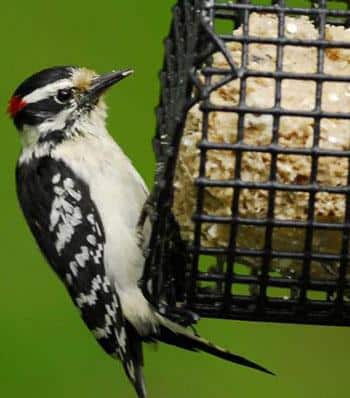Downies, the Pocket-Sized Woodpeckers

Downy Woodpecker at suet feeder
Photo credit: Jim Williams
by Val Cunningham
Contributing Writer
As the season changes, our ‘old reliables’ are moving back to center stage in backyards and at bird feeders.
A look out the window reveals cardinals hopping on the ground, searching eagerly for seeds and insects. Chickadees flit from feeder to feeder, savoring the black oil sunflower, nyger and safflower seeds. And downy woodpeckers swoop onto the suet basket and peanut feeder, chipping out high-energy bits to consume on the spot or store for later.
Yes, at the end of autumn, as birds are starting the process of preparing for winter, the species we see in the backyard are those that remain throughout the year. The nuthatches, woodpeckers, chickadees, goldfinches and house finches—and even the bright cardinals—may get lost in the shuffle during summer’s frenetic breeding season, when migrants augment the bird census. But now, when nearly all migratory birds have winged out of the state, is the time when the year-rounders come into their own.
Trees bring downies
If you have trees in your neighborhood, you have downy woodpeckers nearby, and if you fill feeders with shelled peanuts, suet and/or black oil sunflower seeds you’ll be feeding downies. This tiny woodpecker, running 6 inches from beak to tail tip, is the smallest in North America. Downies don’t seem to mind proximity to humans and in fact may seem almost tame.
The larger woodpeckers that visit our feeders, the hairys and red-bellieds, are easily spooked and lift off the minute the back door is opened. But if a downy is pecking at peanuts when I go out to refill the feeder, the small bird will simply scoot around to the back and continue feeding. Only when it almost seems as if I could reach out and catch it will the downy finally flit away. They’re easy-going, industrious little birds and very tolerant of human activities.
Ever wonder how downies got their name? A close look at the white area along a downy’s back reveals soft, fluffy feathers that look like down, so an early ornithologist gave it that name. Although males and females look almost exactly alike, they’re easy to tell apart, since only males have a red patch at the back of the head.
‘Picky’ beaks
Downy beaks are the shortest in the woodpecker family, and the small birds use them more as a pick than a drill to glean insects from bark in forests and woodlands. One of their favorite food sources lurks inside those round galls so often found on goldenrod stems. Their beaks work just fine for chipping into a gall to extract the juicy fly larva inside.
It’s unfortunate that some people think that woodpeckers kill trees, when quite the opposite is true. Woodpeckers pecking into a tree is a sign that it’s already been damaged by insects or fungi. By feasting on insects they find in a tree, woodpeckers may actually slow the spread of the damage.
Live wood is very difficult for even big-beaked woodpeckers to drill into, which is why they prefer to chip into dead trees and limbs, often rife with tasty insects. However, in cities and suburbs, where we zealously prune the urban forest, dead wood is in short supply, creating a scarcity for woodpeckers looking to feed and roost.
Adaptable downies use their small beaks to peck out a nesting hole or roosting cavity in small limbs, those that may escape the notice of our pruning saws. This helps explain why they can thrive in urban environments and are the most likely woodpecker to visit our feeders. There may be more of these little guys in the neighborhood than we know: a naturalist/bird bander in Iowa decided, some years back, to set up his nets and band all the downies visiting his feeders. At the end of a year’s time he’d recorded 80 different downy woodpeckers, a mind-boggling number.
Keep your eyes on these busy little woodpecker and who knows, he or she may be just one of dozens visiting your feeders.
Downy sounds
This woodpecker makes interesting sounds, announcing its presence with a “pik’ call, or, less often, uttering a whinny (hear downies here).
A winter boost
Here are some steps you can take to help backyard birds survive through the winter:
• Leave berries, fruits and seed-bearing flower heads intact for winter birds;
• Gather logs and limbs into a brush pile, a welcome respite from winter winds
(read how-to tips here).
• Leave patches of leaves under trees and shrubs as foraging spots for birds; and
• Leave birdhouses outdoors for birds to use as night roosts.
• Visit this site for more tips.
St. Paul, Minn., resident Val Cunningham, who leads bird hikes for the St. Paul Audubon Society and writes about nature for local, regional and national newspapers and magazines, can be reached at valwrites@comcast.net



